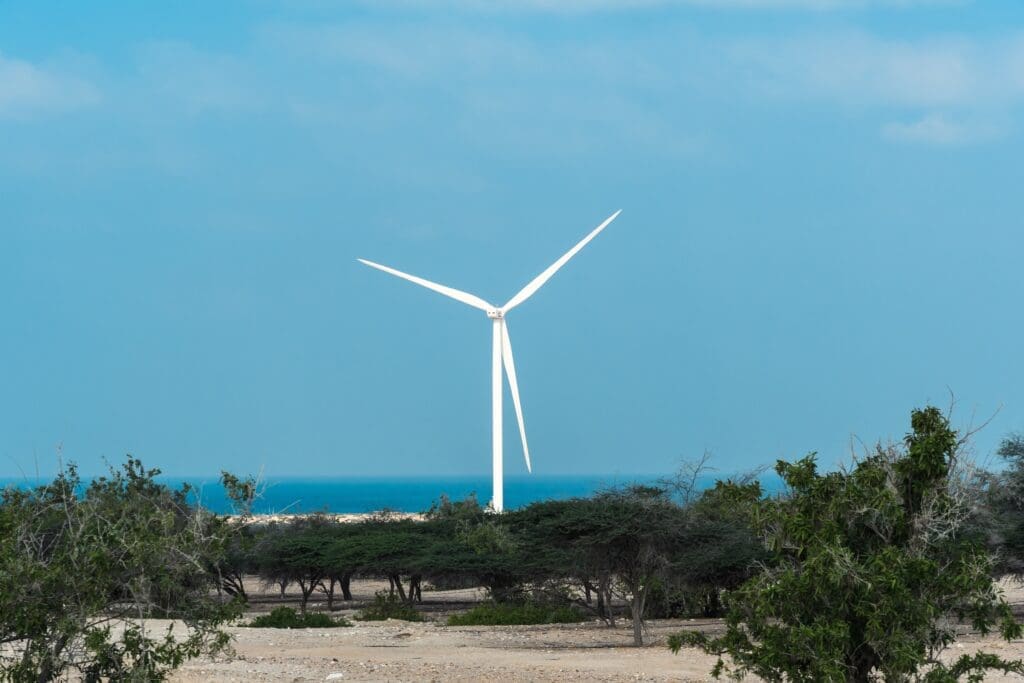
Carbon Markets and Emission Reduction Strategies for Achieving Net Zero Emissions in the MENA Region
February 2025
Introduction
The world has about a decade left to avoid the irreversible impacts of climate change, according to the UN Intergovernmental Panel on Climate Change (IPCC).1 Achieving a more sustainable future will require substantial financing, targeted investments, and global cooperation to reduce greenhouse gas (GHG) emissions. Carbon markets can play a role in achieving these goals, but first they need to become more robust and credible. While the global carbon market has evolved fast over the past five years,2 it remains fragmented into various marketplaces, frameworks, and approaches, hindering rapid decarbonization on a large scale.
These structural and operational challenges include a lack of trust in the environmental integrity, credibility, and additionality of carbon credits. Although compliance carbon markets are well established, they have been adversely affected by diverging regulatory requirements and varying stages of development between jurisdictions, as well as disparate climate ambitions, preventing greater convergence. Voluntary Carbon Markets (VCMs), on which governments, organizations, and individuals can purchase credits, also tend to be fractured, partly because of the sheer number of actors operating within them.
By early 2023, as a growing number of companies looked to implement net-zero strategies, momentum appeared to be gathering in VCMs.3Developing countries, such as those in Africa, announced ambitious plans to use revenues from credits generated from their forests to boost their economies.4 New market arrangements also promised that carbon credits could kickstart climate finance5 and spur innovation in clean technologies.
Many countries are developing carbon markets, including in the Middle East and North Africa (MENA),6 where many governments have announced Net Zero targets, including the United Arab Emirates (2050),7 Oman (2050),8 Bahrain (2060),9 Saudi Arabia (2060),10 Kuwait (2060),11 Lebanon (2050)12, and Tunisia (2050), among others.13 While carbon markets aim to reduce emissions and enhance corporate action, rigorous impact evaluation is needed to ensure that these markets are designed and implemented to ensure equitable and effective climate action.
This chapter aims to provide a comprehensive analysis of current carbon emissions, net zero targets and carbon markets in the MENA region, as well as international collaboration efforts in the Gulf. By leveraging their unique position in the energy market, investing in technological innovation, and fostering international collaboration, Gulf countries can make significant strides towards reducing carbon emissions and achieving their net zero ambitions.
Current Carbon Emissions in the MENA Region
The Middle East is endowed with half the world’s known crude oil reserves14 and 40% of its natural gas.15 Its per capita annual emissions are among the highest of any region in the world (13 tons of CO2 equivalent, or tCO2e), trailing North America (19 tCO2e) but almost double Europe (7.8 tCO2e). Only half of MENA’s 16 nations have committed to net zero targets. The transition to low-carbon energy poses critical questions to the region’s oil and gas producers, as it may imply sustained pressure on their hydrocarbon-reliant development models. Without economic reforms, this may translate into macroeconomic imbalances and ultimately put established social contracts in the region at risk. Despite some nations setting ambitious targets, the region’s emissions are still forecast at two billion tonnes (Bt) CO2 through 2050.16
To reach net zero, the Middle East must electrify and deploy new technologies in its industrial sector and meet increased power demand through fully decarbonized supply, which eliminates emissions from one of the largest sources of greenhouse gases—electricity generation. Heavy industry will require widespread deployment of Carbon Capture, Utilization, and Sequestration (CCUS), with remaining emissions offset through nature-based solutions and carbon markets.
The Role of Carbon Markets
Carbon markets offer a pragmatic and cost-effective approach to decarbonization, functioning as a mechanism for organizations to offset emissions that are challenging to eliminate. Project-based carbon credits are generated through activities that reduce or remove greenhouse gas emissions, such as forestry, mangrove restoration, methane capture, and soil-carbon sequestration. As climate goals become more ambitious, carbon credits will play an increasingly essential role in accelerating decarbonization and contributing to global net-zero objectives. A robust carbon credit strategy can yield additional benefits, including enhanced market access, customer attraction, talent retention, and improved business resilience against climate challenges.
Demand for carbon credits stems primarily from the drive to comply with regulations, fulfillment of corporate net-zero transition frameworks, meeting Paris Agreement climate targets, and meeting voluntary climate-related goals, such as carbon neutrality or net zero.
Many governments use carbon credits to support their climate objectives, by implementing carbon taxes and cap-and-trade schemes, and working towards national Paris Agreement targets. Companies can participate in VCMs either individually or as part of industry-wide schemes. For example, airlines taking part in the Carbon Offsetting and Reduction Scheme for International Aviation (CORSIA), which was set up by the aviation sector to offset its greenhouse gas emissions. International airline operators taking part in CORSIA17 have pledged to offset all the CO2 emissions they produce above a 2019 baseline.
Table 1: Carbon Market Terminologies
| Term | Definition |
| The Global Carbon Market | The Paris Agreement’s Article 6 rulebook (6.2, 6.4 & 6.8) provides more consistent carbon-trading standards since COP26, which established an architecture for international carbon markets and clarified how governments should account for credits in national emissions targets. |
| VCMs | Marketplaces or market initiatives with regulations guiding the supply, demand and use of carbon credits. |
| Compliance Carbon Market | Marketplaces in which regulated entities buy and surrender emissions allowances or offsets to meet regulatory targets. Examples include the EU Emissions Trading System. |
The Paris Agreement’s Article 6 rulebook is widely seen as key to helping carbon markets grow. It laid the groundwork for a UN-run global trading system modeled on the Kyoto Protocol’s Clean Development Mechanism (CDM). Article 6.2 specifies how to account for carbon credit transfers;18 Article 6.4 establishes an architecture for international carbon markets and clarifies how governments should account for credits in national emissions targets.
In addition to the United Nations Framework Convention on Climate Change (UNFCCC)’s efforts under Article 6 19 of the Paris Agreement, industry associations and other global organizations are advancing initiatives to bolster market transparency, foster innovation, and deliver carbon credit benefits. Private-sector groups, such as the Integrity Council for the Voluntary Carbon Market (ICVCM)20 and the demand-side-focused Voluntary Carbon Markets Integrity Initiative (VCMI),21 are working to build trust in carbon credits and guide businesses on their use.
Carbon Markets in the MENA Region
Several MENA countries have launched carbon market programs. The UAE has established the world’s region’s first regulated carbon credit trading exchange and clearing house.22 Saudi Arabia launched its Greenhouse Gas Crediting and Offsetting Mechanism to Advance Global Climate Goals (GCOM),23 while Egypt24 launched its VCM in July. Oman,25 Morocco26 and Tunisia27 have also established policies and regulations for carbon credit verification and certification standards.
The state of Article 6 mechanisms and VCMs varies across the MENA region. Saudi Arabia is at the forefront, with its Regional Voluntary Carbon Market Company (RVCMC),28 which aims to scale up VCMs and support sustainable business practices. The UAE is also active, with initiatives like the UAE Carbon Alliance. Egypt has launched Africa’s first regulated VCM, facilitating the trading of carbon reduction certificates on the Egyptian Stock Exchange, aligning with global efforts to enhance both voluntary and compliance markets.
The rise of new carbon credit markets, including under Article 6, is reshaping the global landscape, bringing integrity and transparency to global carbon trading. Countries in the Middle East, particularly UAE and Saudi Arabia, are positioning themselves as emerging hubs for carbon offset trading and ecosystem for carbon markets. Dubai Financial Centre (DFM) and Abu Dhabi Global Market (ADGM) are at the forefront of carbon trading initiatives in the UAE, with DFM launching a pilot program for carbon credits trading and ADGM establishing the world’s first regulated carbon credit trading exchange. Offset8 Capital has launched the Middle East’s first regulated carbon credit fund focusing on nature-based solutions,29 highlighting the UAE’s leadership in creating a sustainable and transparent marketplace for carbon offset initiatives.
Qatar is also actively engaging in discussions on carbon markets and exploring opportunities under Article 6. Qatar’s Ministry of Environment and Climate Change has started actively working on carbon markets,30 including at a workshop ahead of COP29.31 Although Qatar has low interest in VCMs, the Qatar-based Global Carbon Council in 2019 launched a crediting standard aimed at making its credits eligible both for VCMs and Article 6. Qatar also purchased 1.8 million carbon credits from the Council32 to help meet its FIFA World Cup 2022 carbon neutrality pledges,33 a move that was heavily criticized.34 The Council’s decision to qualify renewable energy projects in emerging economies still strongly divides opinion, and carbon credits generated from such projects have failed to obtain a new quality label from the Integrity Council for the Voluntary Carbon Market (ICVCM)35, an independent watchdog that aims to address widespread concerns over the quality of carbon credits.
Gulf Cooperation Council (GCC) countries also face similar challenges and opportunities in navigating this new terrain. The European Union’s Carbon Border Adjustment Mechanism (CBAM) is expected to significantly impact MENA countries by imposing costs on carbon-intensive imports, as well as hitting the shipping industry by increasing operational costs and incentivizing the adoption of cleaner technologies. This could challenge economies that rely on exports of such goods.
Carbon markets nevertheless present a key opportunity for MENA countries to mitigate these impacts. That said, some MENA countries are still developing their carbon market strategies. While some have introduced carbon marketplaces, the region’s overall engagement with Article 6 remains in its early stages. The focus is on building capacity and establishing robust frameworks to facilitate participation in both compliance and voluntary markets. This involves collaboration with international bodies and leveraging regional initiatives to align with global carbon market standards and objectives.
Climate commitments and carbon market development in the MENA countries vary significantly. Here is an overview:
Table 2: Emissions Reduction Targets and Carbon Market Initiatives of MENA Arab Countries
| Country | GHG Reduction Targets (Nationally Determined Contributions) | Net Zero Target | Carbon Market Initiatives |
| Algeria | 7% by 2030 | N/A | Involvement in VCMs. |
| Bahrain | 30% by 2035 | 2060 | Active in MENA VCM, launched “Safa” platform for voluntary carbon offsetting.36 |
| Egypt | 37% by 2030 | N/A | FRA regulations for CERs including accreditation and carbon trading37, Egyptian Carbon Exchange introduced in 2022 ahead of COP27.38 |
| Iraq | 15% by 2030 | N/A | Participates in VCM, first carbon exchange franchise with Capturiant and Sharp Mind Global Ventures.39 |
| Jordan | 31% by 2030 | N/A | Involvement in VCMs through the Ministry of Environment. |
| Kuwait | 7.4% by 2035 | 2060 | Efforts to establish VCM, supported by Kuwait Finance House’s carbon offset platform.40 |
| Lebanon | 20% unconditional, 31% conditional by 2030 | 2050 | Some involvement in carbon markets. |
| Morocco | 18.3% unconditional, 45.5% conditional by 2030 | 2050 | Article 6 MoU with Switzerland, Norway and Singapore MoU to establish regional VCM.41 |
| Oman | 21% by 2030 | 2050 | Draft of general policy framework for carbon markets, aligns with Article 6. |
| Qatar | 25% by 2030 | N/A | Developing VCMs, QFC Digital Assets Framework using DLT, houses independent standard Global Carbon Council. |
| Saudi Arabia | 278 million tonnes of CO2e to be reduced annually by 2030, 50% of energy mix from renewables by 2030 | 2060 | Launch of RVCMC, advancing carbon market with GCOM and established Saudi Carbon Exchange.42 |
| Tunisia | 41% by 2030 | 2050 | Involvement in VCMs; partnerships with Japan, Singapore, and Switzerland under Article 6.43 |
| United Arab Emirates (UAE) | 40% by 2030 | 2050 | Active in both Article 6 and VCMs, National Register for Carbon Credits initiative; established first regulated carbon credit trading exchange and clearing house in the world under Abu Dhabi Global Market (ADGM);44 Dubai Financial Market (DFM) developed pilot program for trading carbon credits.45 |
Policy Recommendations
It is time to double-down on efforts to make carbon markets a reality in MENA and unblock financial flows that could transform the region and its approach to climate risk. While the private sector’s ambition to meet its decarbonization targets has stimulated significant demand for voluntary carbon markets in the MENA region, compliance carbon markets need to catch up. The following recommendations could help accelerate the speed and expand the scale of carbon markets across the MENA region are based on the current challenges faced in the region:
- Early entry into carbon markets could deliver numerous benefits for MENA countries. The GCC countries’ experience with the CDM since 2012, in which falling CER prices have highlighted the need for a well-functioning market mechanism, provides valuable lessons. Many GCC nations are now exploring domestic carbon markets, and developing effective market-balancing mechanisms will be crucial. Consistent government attention, early institutional development, and proactive capacity-building can help the region act early, seizing opportunities to attract international investments and establish robust carbon trading infrastructures under Article 6.
- Establishing a unified MENA regional carbon market regulatory framework, ensuring integrity, transparency, and international recognition would help achieve greater uniformity across the region. A unified carbon market would offer significant advantages over individual national systems. A larger, regional market would increase liquidity and lower transaction costs, benefiting both buyers and sellers. Harmonized regulations could enhance environmental integrity and promote regional cooperation. The EU Emissions Trading System provides a successful model of a phased approach, cap-and-trade mechanisms, and robust monitoring systems.
- Insufficient supporting infrastructure, such as the lack of national registries or Monitoring, Reporting, and Verification (MRV) systems, hampers the development of the Article 6 market in many Middle Eastern countries. To address this, they should establish comprehensive national registries, implement robust MRV systems, and seek technical assistance and capacity building from international organizations like the UNFCCC, World Bank and IETA. This could create a transparent, reliable environment for carbon credits, accelerating the adoption of Article 6. Encourage private sector involvement by offering incentives and creating a favorable investment climate. This could attract more capital for carbon reduction projects and drive innovation in low-carbon technologies in countries in need. They should also commit to significant purchases in other regions that are looking to build out their carbon crediting infrastructure. For example, the private-sector coalition UAE Carbon Alliance has agreed to buy $450 million worth of credits generated in Africa by 2030.
- Middle Eastern countries must balance the path to net zero with critical economic and social considerations. Establishing both VCMs and compliance markets is essential, as carbon markets can play a significant complementary role in achieving sustainability goals. However, voluntary trading alone will not be enough; a compliance market must be integrated to ensure that the carbon trading program meets its desired objectives and drives meaningful emissions reductions.
The Way Forward
Despite recent setbacks, the international community should not lose hope in the potential for voluntary markets to make progress towards global decarbonization targets and net-zero goals. While some may be quick to dismiss VCMs role in the wake of negative press, heightened public scrutiny, and declining credit value, it would be short-sighted to ignore the progress already made in various markets.
Given the growing complexity of the carbon trade ecosystem and the nascency of many carbon-trading networks and platforms in various Middle Eastern countries in supporting their net zero targets, by working closely with international organizations and providing clear guidance on participation, Middle Eastern countries can establish robust, transparent use of carbon credit in net zero plans.
Carbon markets can support both private and government efforts to reduce, avoid, or remove greenhouse gas emissions and contribute to reaching the goals of the Paris Agreement, while providing benefits to multiple stakeholders. Among other things, well-functioning carbon markets can lower the costs of reducing emissions, supporting the transfer of clean technologies and finance, and unlock higher mitigation ambitions over time. If carbon markets are held to high standards of integrity and transparency, they can help accelerate the transformation needed in the Middle East region by effectively putting a price on pollution and creating an economic incentive for reducing emissions. Carbon markets stand on the brink of reaching the size, depth, and maturity they need to mobilize capital flows to clean-energy solutions and advance the global net-zero transition. The world showed a willingness to make this happen when it passed much-awaited rulebooks after discussions at COP27 and COP28. Now it is time to see those ambitions implemented.


